November 3, 2023
Air Date: November 3, 2023
FULL SHOW
SEGMENTS
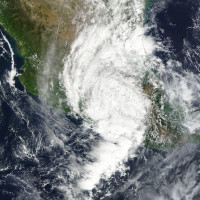
Warming Supercharges Hurricane Otis
View the page for this story
Exceptionally warm waters in the Eastern North Pacific off Acapulco, Mexico fed the rapid strengthening of Hurricane Otis into a deadly Category 5 storm that weather forecasters failed to understand in time to warn the public. MIT Professor of Atmospheric Science Kerry Emanuel joins Host Steve Curwood to explain the science behind the storm and share how needed improvements in weather forecasting can help communities better prepare for extreme storms. (10:02)
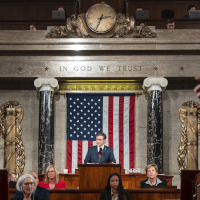
A Climate Skeptic House Speaker
View the page for this story
The new House Speaker, Republican Mike Johnson of Louisiana, has voted for legislation on the environment and some key social issues just 2% of the time, from the perspective of the League of Conservation Voters. Senior VP of Government Affairs Tiernan Sittenfeld joins Host Jenni Doering to voice LCV’s concerns about Speaker Johnson’s climate skepticism, oil and gas industry campaign contributions and bids to repeal President Biden’s signature climate law. (10:10)

Beyond the Headlines
/ Peter DykstraView the page for this story
This week, Living on Earth contributor Peter Dykstra and Host Steve Curwood discuss the nutritional value and relative ease of growing pumpkins. Also, the construction industry offers a huge opportunity to incorporate recycled materials. And in history, they look back to when Congress passed an act to protect the popular striped bass also called rockfish. (04:47)

BirdNote®: Return of the Extinct Little Blue Macaw
View the page for this story
With a little help, some species can make a miraculous comeback, even from extinction in the wild. BirdNote’s Lucina Melesio has this story about a recent avian recovery. (02:06)
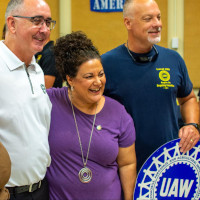
Auto Workers in the EV Fast Lane
/ Dan GearinoView the page for this story
Striking auto workers won higher wages, better benefits, and more ability to unionize electric vehicle battery plants that supply the “Big Three” US automakers. Inside Climate News Reporter Dan Gearino joins Host Jenni Doering to unpack what the strike’s outcome could mean for the growing electric vehicle industry, its workers, and the public. (07:03)
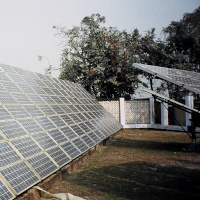
Virtual Power Plants
View the page for this story
The aging grid is struggling to accommodate the surge in renewables like wind and solar . And since they don’t produce electricity around the clock, there’s often a mismatch between when the power is being generated and when it’s being used. Ryan Hledik of the consulting firm The Brattle Group explains to Host Steve Curwood how “virtual power plants” can tap home and electric vehicle batteries and shift the timing of HVAC and appliance demand to help close this gap. (11:20)
Show Credits and Funders
Show Transcript
231027 Transcript
HOSTS: Steve Curwood, Jenni Doering
GUESTS: Kerry Emanuel, Tiernan Sittenfeld, Ryan Hledik
REPORTERS: Peter Dykstra, Dan Gearino
[THEME]
CURWOOD: From PRX – this is Living On Earth.
[THEME]
CURWOOD: I’m Steve Curwood.
DOERING: And I’m Jenni Doering. Striking auto workers gain wins in the new electric vehicle economy after a monthlong walkout
GEARINO: By representing some workers at some battery plants, they can then go to other battery plants and say, hey, look at what we did, look at how much better their job security is, how much better their benefits and wages are.
CURWOOD: Also, fixing the antiquated grid with virtual power plants using software and smart batteries.
HLEDIK: It's this idea where customers have a lot of flexibility in their demand for electricity, customers who are buying electric vehicles have the ability to change when they're charging that car to a degree. Customers with smart thermostats can manage the thermostat in a way that changes when they're cooling their home.
CURWOOD: We’ll have those stories this week on Living on Earth – Stick Around!
[NEWSBREAK MUSIC: Boards Of Canada “Zoetrope” from “In A Beautiful Place Out In The Country” (Warp Records 2000)]
[THEME]
Warming Supercharges Hurricane Otis
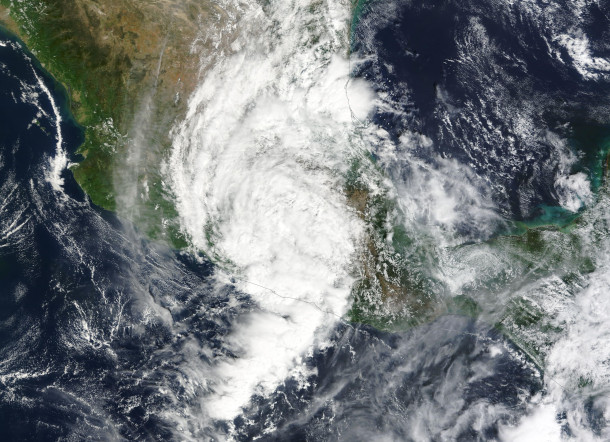
Hurricane Otis continued its explosive intensification episode off the coast of Guerrero during the evening of October 24th. (Photo: NASA, Wikimedia Commons)
DOERING: From PRX and the Jennifer and Ted Stanley Studios at the University of Massachusetts, Boston this is Living on Earth. I’m Jenni Doering
CURWOOD: And I’m Steve Curwood.
Weather forecasting has always been a gamble, but climate disruption has drastically worsened the odds for accuracy. Forecasters recently missed the explosion of Hurricane Otis, which in just 12 hours became a category five storm that left nearly a hundred people dead or missing. Scientists believe that exceptionally warm waters in the Eastern North Pacific off Acapulco Mexico fed this hurricane’s rapid development. Here to explain and consider ways of improving extreme weather forecasting is Professor Emeritus of Atmospheric Science at the Massachusetts Institute of Technology, Kerry Emanuel. Welcome back to Living on Earth Kerry!
EMANUEL: Well, it's great to be back with you.
CURWOOD: Now, by the way, you're familiar with the area of Acapulco, where the storm came ashore. I gather from your research.
EMANUEL: Well, about 30 years ago, a colleague of mine and I ran a field project out of Acapulco called the tropical experiment in Mexico, aka Tex Mex. Where are we were trying to understand the physics underlying the genesis of tropical cyclones by flying into them with research aircraft, making all kinds of measurements. So yes, I was familiar with it 30 years ago,
CURWOOD: I imagine back then, though, you didn't run into a storm like this.
EMANUEL: Not like this one. In fact, I don't think anyone's run into a storm like this one, with the possible exception of Patricia, back in 2015, also in the same general region.
CURWOOD: Now, as you point out, this is a forecasters nightmare. I mean, people originally, were told that this might be a category one storm to come ashore, they're at Acapulco, and then 12 hours later, suddenly, they're talking about a category five hurricane with winds of over 160-165 miles an hour. What do you make of that?
EMANUEL: It's hard to imagine anything worse. And this is something that we drilled ourselves on, the worst case scenario is figuratively going to bed with a tropical storm with no indication in the forecast, that would be much stronger, and waking up the next morning, and it's a cat four, although in this case, it was actually worse than our test case. And not too many hours away from landfall, no time to warn anybody. It's really, really a worst case storm.
CURWOOD: Now, you've been cautious about linking big hurricanes to climate disruption from human activities. How do you think Otis might be related to that?
EMANUEL: Well, it's normally very, very difficult to say anything about the relationship between a particular storm and climate change, whether it's El Niño, something else, or global warming, we are much more comfortable looking at the statistics of storms. But we do know that there's a speed limit, it's imposed by thermodynamics that puts an upper bound and how intense a storm can get. And it puts an upper bound on its rate of intensification. And Otis was right at that limit. And the limit itself was very high because the water was so hot there. So I would go out on a limb and say a storm intensifying that fast was probably not physically possible 40 or 50 years ago.
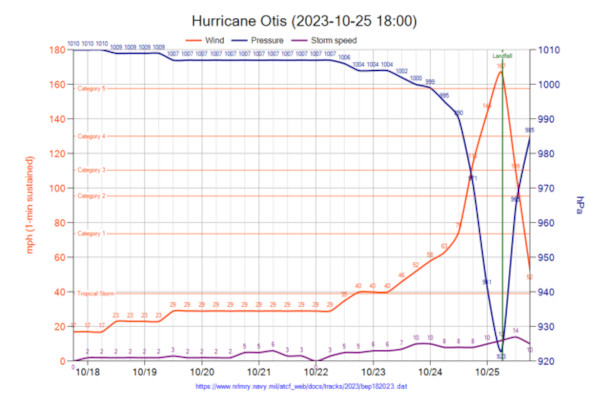
Using data from the US Naval Research Laboratory, this graph shows the rapid increase in wind speed before and during Hurricane Otis. (Photo: Phoenix7777, Wikimedia Commons)
CURWOOD: Now, the ocean absorbs a lot, perhaps most of the excess heat from greenhouse gas emissions. And of course, the temperatures in the ocean are getting higher and higher. What are the physics of this warming and the intensity of hurricanes such as Hurricane Otis?
EMANUEL: So when you make the climate system warmer, it's possible to have hurricanes that are more intense, they're not necessarily more frequent. In fact, they may actually become a little less frequent. But this cap on their intensity goes up. What's really interesting for us, and so far kind of hard to predict, is the pattern of warming, it's very easy to fall into the trap of thinking that global warming is globally uniform, but it isn't. And the pattern of warming is much more influential in hurricanes, then the mean warming is. So for example, if the Atlantic warms up faster than the rest of the tropics, we would expect to see a large increase in activity there if that were the case. But we're not so very confident in our predictions of the pattern of global warming.
CURWOOD: So what if anything is special about the eastern Pacific tropical cyclones that we call hurricanes?
EMANUEL: Yeah, there's something very interesting about the Eastern North Pacific, the waters to the west of Central America and Mexico, and that is that they're much fresher at the surface than other parts of the tropics that are susceptible to hurricanes, that is there less saline. That's important because fresher water is also lighter it tends to like being at the surface. Normally, when a hurricane comes along, it turns up cold water from deeper down. And that limits its intensity. It's a very important effect, especially on strong storms. But in eastern Pacific, this salinity stratification, the fact you get saltier as you go down. And therefore heavier, tends to damp out that mixing. And we find in our models is to get reasonable statistics of intensity in eastern Pacific hurricane, we have to include that salinity effect. And that makes them stronger than they would otherwise be.
CURWOOD: So talk to me about how you scientists track hurricanes and how we can improve that science and technology.
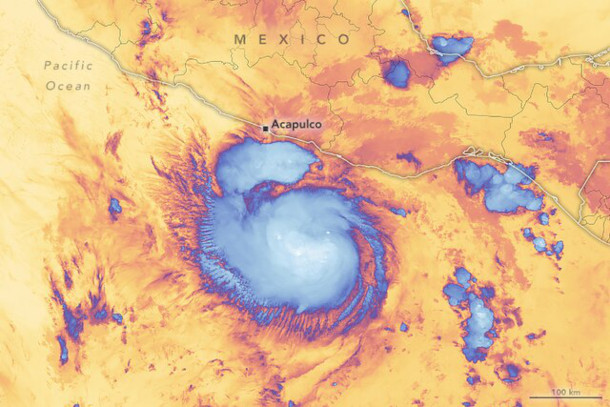
Hurricane Otis rapidly developed from a category 1 to category 5 storm. This image depicts what the storm looked like at 2:30 am in the tourist town of Acapulco. (Photo: Michala Garrison, NASA Earth Observatory, Wikimedia Commons)
EMANUEL: Well, there are a lot of improvements that we can make. Certainly the first thing I would focus on is improving our understanding of the physics of storms. It's not just a question of technology. But having improved that understanding where they're better positioned to build better models, we should definitely be moving away from what we call a deterministic forecast — a single forecast of a track and of intensity — and move into the probabilistic world. Where are we, at a given time make 50 or 100, or 1000 forecasts, which differ only in slightly different, but equally probable realizations of the initial condition, or in different but equally plausible parameters in the model so that we can bound the probabilities of these and we should translate that, and this is the really tough part, is to translate that into a very concise, beautifully worded description for the public, and for emergency managers, and so forth, so that they are aware not only of what we think might happen, but also we think might possibly happen. It's so important in this case, we might have been able to say, yeah, there's an outside chance that's going to intensify rapidly if we had good models, and we were doing things probabilistically.
CURWOOD: Now, how do you deal with the psychology of that though, because if you say to a town, let's say resort town, like Acapulco, Mexico, that, you know, as a probable chance that something kind of grouchy could come through here, human nature is well, okay, but they only think it's likely or possible, I don't know, I'm gonna just, I'm just gonna keep going until I hear that it is or it isn't.
EMANUEL: It's much more important for people like emergency managers whose business it is to make decisions, for example, whether to evacuate or not, to have that good probabilistic information. For example, last year, there was Hurricane Ian, that affected Southwestern Florida and one of the towns had a rule it made for itself, that if the probability of there being more than a foot of water at a certain place in town was more than x percent, I don't remember what it was 30%, something like that, they would evacuate. So they had learned how to use probabilistic information to make decisions, you can't expect just a random member of the public necessarily to be thinking that way. But you know, we already do that you get on your smartphone, you want to know what the weather is going to be tomorrow, it says a 75% chance of rain, you get used to interpreting that. Okay, I'll take my umbrella. And of course, it's much more important when we're trying to forecast some kind of life-threatening weather like a hurricane.
CURWOOD: So what's to be done? In terms of dealing with hurricanes and the public? And the various risks? I mean, what steps can we take two make better predictions about what's going to happen with hurricanes in their intensities to protect the public health.
EMANUEL: But I think there's two things we scientists can do. First of all, we have to do a much better job projecting long term risk, and how that's changing as the climate changes so that people can make intelligent decisions about where they're going to live, what they're going to build, and so on, we need to move into this probabilistic world and make many many forecasts to bracket, the possibilities, and not just to say, well, this is our best shot and what's going to happen. We need better models, we need better computers, so that we can resolve the atmosphere better, we need to make better measurements of the ocean below the surface, that's really tough to do. You can see the surface temperature with satellites, but you need to know the temperature and salinity of the water down to 100 meters or so if you really want to make a good forecast of an intense hurricane. So there's all those things. And I would add to that you get away from the science, our science, at least into social science and policy, we really have to get a hold of this business of subsidizing risk and stop doing it. And let premiums— it may be painful to do this — but at least get to the point where insurance premiums actually reflect the risk people are undertaking so that they are discouraged from moving and building in risky places.
CURWOOD: Professor Emanuel want to thank you for taking the time with us today. Kerry Emanuel is a professor emeritus of atmospheric science at the Massachusetts Institute of Technology (MIT). Thanks so much.
EMANUEL: Thank you very much.
Related links:
- The Conversation | “Extreme Weather Is Outpacing Even the Worst-Case Scenarios of Our Forecasting Models.”
- Science | “Hurricane Otis Smashed into Mexico and Broke Records. Why Did No One See It Coming?”
- Tropical EXperiment in MEXico (TEXMEX) Headed by Dr. Kerry Emanuel
- More info on hurricane Patricia
- More information on the relationship between global warming and climate change
- Learn more about Dr. Emanuel’s work!
[MUSIC: Nestor Torres “Ain’t No Sunshine”]
CURWOOD: Rising global temperatures also spell trouble for ice in Antarctica.
ALLEY: Antarctica's ice cares about warming, it cares about change. The ice shelves love the coldest water in the world ocean. And that means change is bad for them, because if you change the winds, you change the currents, you change the temperature. It can't get better, but it can get worse. You can't bring in colder water because there isn't any colder water. So changing things is bad for Antarctic ice if you want to keep ice on Antarctica. And so, finding the solutions that limit warming is really the thing that Antarctica wants.
CURWOOD: Tune in to Living on Earth next week to hear that and much more.
DOERING: Last week our guest stated that Saudi Arabia’s state oil company Aramco is “also partially owned by the US.” We want to clarify that he didn’t mean the US government, but rather US investors who do own portions of Aramco, which has US subsidiaries.
[MUSIC: Nestor Torres “Ain’t No Sunshine”.]
Coming up, a look at the new speaker of the US House and his record on the environment.
That’s just ahead. Stay tuned to Living on Earth.
ANNOUNCER: Support for Living on Earth comes from Sailors for the Sea and Oceana. Helping boaters race clean, sail green and protect the seas they love. More information @sailorsforthesea.org.
[MUSIC: Nestor Torres. “Velvet Nights”]
A Climate Skeptic House Speaker

Representative Mike Johnson (LA-04) was elected House Speaker in October 2023. (Photo: Office of Speaker Mike Johnson, Wikimedia Commons, Public Domain)
CURWOOD: It’s Living on Earth, I’m Steve Curwood
DOERING: And I’m Jenni Doering.
After tumultuous weeks of failed votes, the Republican led House of Representatives finally elected a new Speaker of the House on October 25th. Speaker Mike Johnson represents the 4th congressional district in Louisiana, a state that’s an oil and gas hub. Speaker Johnson’s far-right conservative record and endorsement by former President Trump have drawn sharp criticism from many liberals and moderates, including progressive conservation advocates. The left-leaning League of Conservation Voters keeps track of how elected officials vote on legislation on the environment and some key social issues. And from their perspective Speaker Johnson has only aligned with them two percent of the time since first winning his seat in 2017. Tiernan Sittenfeld is the Senior Vice President of Government Affairs for the League of Conservation Voters and she joins me now from Washington. Tiernan, welcome back to Living on Earth!
SITTENFELD: Thank you for having me. It's good to be back.
DOERING: So, Speaker Mike Johnson has a League of Conservation Voters lifetime score of 2%. That's almost as low as it gets. What does that actually mean?
SITTENFELD: Unfortunately, Speaker Mike Johnson is incredibly extreme across the board. And that is absolutely the case when it comes to his record on combating the climate crisis, on clean energy, on environmental justice. Basically, at every step, he has stood in the way of progress on all of that. I think he's literally taken only four votes that we would consider pro-environment out of more than 160 during the course of his career. Those are the votes that the League of Conservation has included in our national environmental scorecard during the time that he has been in Congress. And that is just appalling. To vote against the air we breathe, the water we drink, the lands we cherish 98% of the time, is just beyond the pale. And we need to ask ourselves, why is he doing that? And one of the very biggest reasons, is the large amounts of money that he has taken from the oil and gas industry. And to call him a climate skeptic is generous, he's said outrageous things about climate change, and what's causing it, whether he believes it's happening. And then even just in his first few days as Speaker, he has gone after the affordable clean energy plan that's known as the inflation Reduction Act. It's the biggest step our country has ever taken to combat the climate crisis, to invest in environmental justice, to advance clean energy jobs, and make sure that they are good-paying, family-sustaining jobs. And he is trying to gut that, he is going after badly needed funding at the Environmental Protection Agency, and so much more. So this is someone who is really extreme and acting at the behest of Big Oil day in and day out.
DOERING: So 2% is an extremely low score, in terms of this environmental scorecard from the League of Conservation Voters. But how does that compare to other members of Congress?
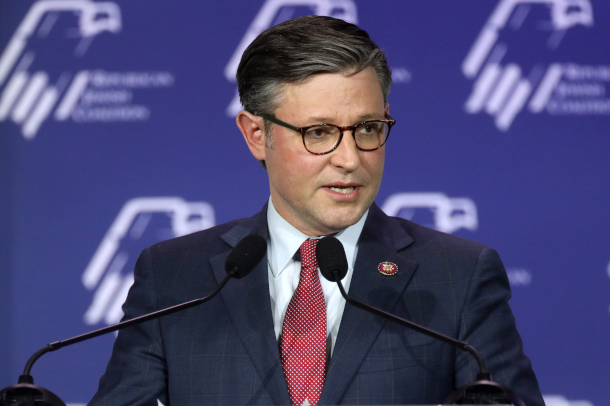
Speaker Johnson has taken over $330,000 in donations from the fossil fuel industry, according to LCV. (Photo: Gage Skidmore, Flickr, CC BY-SA 2.0)
SITTENFELD: Well, perhaps a good comparison would be to the former speaker, Kevin McCarthy. His was 4%. So actually, I guess you could say double what the current speaker has. But whether it's 2%, which is what Speaker Mike Johnson has, or 4%, what former Speaker Kevin McCarthy had, those are appalling. And we also saw that as Speaker, Kevin McCarthy, really had the House cater to polluters, especially to Big Oil and Gas day in and day out. They have gone after the very popular Inflation Reduction Act and the clean energy provisions that are really jumpstarting a clean energy economy. Supercharging it, in fact, I would say. In fact, our partners Climate Power are out with a new report that since the enactment into law, the inflation Reduction Act, there have been more than 210,000 jobs created in the clean energy space. There are new clean energy projects in 45 states across the country. So we are seeing incredible progress. So then it really does beg the question of why would this new Speaker be trying to gut all of that and overturn it? I think what we're seeing is just the Republican leadership of the House of Representatives, is catering to over-the-top, irresponsible parts of their party. And I think they do so clearly at the peril of our planet, and also at the political peril of many of their incumbents. And they do not have a mandate to be gutting this progress. Our polling shows across the country, people overwhelmingly support clean energy jobs, want investments in climate solutions and environmental justice, are more likely to support candidates who believe that the climate crisis is a problem and that addressing it provides all kinds of opportunities.
DOERING: Well, so bipartisan work does seem fairly rare these days in Congress. But what kind of bipartisan legislation on the environment and climate might provide a path forward for Democrats and Republicans to work together in the coming months on these urgent issues?
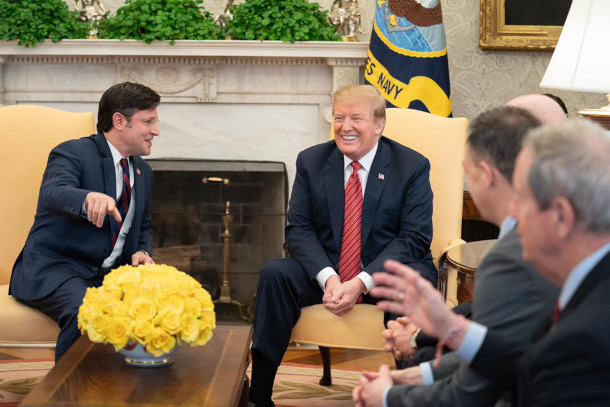
Speaker Mike Johnson holds several far-right political positions and led House attempts to overturn the 2020 presidential elections. (Photo: Office of Speaker Mike Johnson, Wikimedia Commons, Public Domain)
SITTENFELD: Well, we would love to get back to a place where Democrats and Republicans come together to pass really necessary environmental legislation. And this is actually at the start of the environmental movement. And if you think of our bedrock environmental laws: the Clean Air Act, the Clean Water Act, the Endangered Species Act, all of these bedrock environmental laws were passed by overwhelming bipartisan majorities, and then signed into law by a Republican president. But unfortunately, with Citizens United, with the Koch brothers, with the incredibly corrosive impact of fossil fuel money flooding into Republican candidate coffers, we have seen that the Republican Party has really abandoned its historic conservation roots and now stands in the way of clean air, clean water, protecting our public lands. Obviously, at the League of Conservation Voters we believe strongly that we can't have a healthy climate without a healthy democracy, that they are inextricably linked. And again, we're talking mostly about climate. But if you look at him being one of the architects of trying to overturn the 2020 elections, if you look at where he stands across the board on LGBTQ+ issues, on abortion, he is extreme to the maximum.
DOERING: Well, so there are members of Congress and their views on issues. But then there's also just average Republican voter. And increasingly, we're seeing young Republican voters really speak out about climate change, and we need to do something about this climate crisis. So what do you think that means in terms of the way that the rhetoric on climate in the Republican party might need to shift over the years?
SITTENFELD: We know that people across this country absolutely are concerned about the climate crisis, this is not a distant threat. It is not abstract. It is the reality that people are experiencing and suffering from today. From floods, to fires, to record-breaking heat, it is causing untold suffering. And people want solutions. And the good news is they know that the solutions are there. We are already seeing good-paying, family-sustaining jobs being created, thanks to the Inflation Reduction Act all across the country. And we're seeing record investments in environmental justice, while of course, much more is needed. So we know that this is popular, including with Republicans, especially with young Republicans, because they know their future is on the line. And so I would say that Republicans in Congress are out of step, not just with most people in the country, but even with a lot of Republicans and certainly with most young Republicans who really do want them to support and invest in climate solutions, rather than acting at the behest of Big Oil every single day.
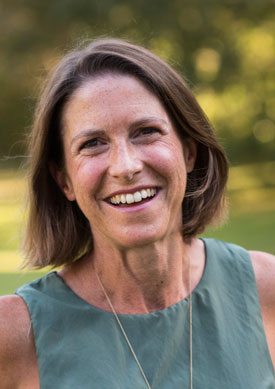
Tiernan Sittenfeld is the Senior Vice President of Governmental Affairs for the League of Conservation Voters. (Photo: Courtesy of League of Conservation Voters)
DOERING: And what opportunities do you see for younger, climate-concerned Republicans to push Speaker Johnson to move some legislation forward?
SITTENFELD: I think young Republicans around the country have a big opportunity to push their elected officials. At the League of Conservation Voters and with our 30+ state LCV partners around the country, we put out a national environmental scorecard that people are able to track in real time how their elected officials are voting when it comes to these pressing issues. And are they standing up for clean energy and environmental justice and climate solutions? Not to mention, clean air, clean water, democracy, so much more? Or are they siding with their polluter allies? At LCV, we often say that elections have consequences. We are seeing the most stark contrast from Democrats coming together and doing the biggest thing ever on climate, environmental justice, and clean energy with the Inflation Reduction Act in the last Congress. There were actually some bipartisan legislative victories in the previous Congress. And now we are seeing this extreme, MAGA, House Republican leadership grind all of that to a halt. The great thing is we still have a pro-environment majority now as it is in the Senate, and we still have the Biden-Harris administration working to make progress through their executive action, especially at EPA for things like power plants and clean cars and trucks and methane. But we are hurtling toward the 2024 elections. This election cycle could not be more important. The stakes could not be higher, so people absolutely need to get out there and vote and to help elect environmental champions up and down the ballot.
DOERING: Tiernan Sittenfeld is Senior Vice President of Government Affairs for the League of Conservation Voters. Thank you so much, Tiernan.
SITTENFELD: Thank you, Jenni.
DOERING: We have invited Speaker Mike Johnson or someone from his team to speak with us but have yet to hear back. We have also reached out to the Republican Conservative Climate Caucus led by Utah Congressman John Curtis to discuss the likely environmental agenda of the new Speaker. By the way, although Speaker Mike Johnson has just a 2 percent score from the League of Conservation Voters, there are some Republican members of the House who have earned significantly higher lifetime scores in part because of their willingness to vote for bipartisan environmental legislation. They include New Jersey members Jefferson Van Drew and Christopher Smith with scores of 55 and 60 percent, respectively, and Brian Fitzpatrick of Pennsylvania with an LCV score of 74%.
Related links:
- The League of Conservation Voters | “LCV Statement on House Republican Speaker”
- Speaker Mike Johnson’s National Environmental Scorecard
[MUSIC: Oil by Gorillaz]
Beyond the Headlines

New studies indicate that edible pumpkins could be a valuable crop in developing countries due to their nutritional value and climate resiliency. (Photo: Suzie Tremmel, Wikimedia Commons, CC BY 2.0)
DOERING: It’s Living on Earth I’m Jenni Doering.
CURWOOD: On the line now from Atlanta, Georgia is Peter Dykstra — Living on Earth contributor who looks beyond the headlines for us. And hi there, Peter, how you doing today?
DYKSTRA: Hi, Steve. I'm doing well. And I hope you are too. And why am I about to start talking about pumpkins, when it's already after Halloween? It’s because pumpkins are being viewed in the developing world as a potential superfood, low calorie, containing antioxidants containing vitamin C, vitamin A, a whole lot of other valuable things. They're easy to grow. They resist drought, they resist heat. And so pumpkins may be on the rise elsewhere for something other than the dreaded pumpkin spice.
CURWOOD: Although I have to confess that I do like pumpkin pie. So what's the research that tells us that pumpkins really, it would be a great deal for the less affluent part of the planet.
DYKSTRA: In 2021, a Malaysian University called pumpkins, a revolutionary age crop, after they did a study found they were a balanced food could grow almost anywhere.
CURWOOD: I have to say what I've had success with them in my garden, they almost take over the thing, so they can be fairly prolific.
DYKSTRA: Yeah. And when I tried to grow pumpkins in Georgia, even though a lot of people have great success around here, my pumpkins could not be seen by the naked eye.
CURWOOD: Hey, what else do you have today?
DYKSTRA: Recycling and the construction industry. In many places, it's widespread. If you want to get a green building certification in the United States, you have to use recycled material for a new building. But in all the new building that's going around the world, recycling isn't yet a thing. It's a huge contributor, all of those used and discarded construction materials, everything from wood, to metals to stone to concrete, are a huge source of carbon emissions. Replacing them with new stuff is another source of carbon emissions. Some say it's one in 10 tonnes of carbon emissions worldwide. And recycling is a way to cut that big chunk of what we're putting into the atmosphere putting into greenhouse gases by reforming the construction industry.

Although recycling building materials is common in wealthier countries, developing countries have a long way to go if they want to negate the impact of new construction on the climate. (Photo: Reuse Warehouse, Flickr, CC BY 2.0)
CURWOOD: So this sounds like this is a huge potential to help reduce climate changing gases, but so far not well used around the Earth.
DYKSTRA: Now, in some areas, it is in the US and Europe. It's becoming widespread in much of the developing world, there's still a long way to go in worldwide new construction, places where construction is booming, like some of the oil rich cities in the Middle East, to bring the industry up to meeting its goals in lessening a huge contribution to greenhouse gases.
CURWOOD: Hey, Peter, let's take a loo now, back in the history volumes, tell me what you see.
DYKSTRA: Oh, Steve, October 31, 984 would have been a red letter day for both rock fish and striped bass if those fish use letters.
CURWOOD: But wait rockfish and Stripe best, man, I think those are the same fish. Some people think right?
DYKSTRA: You got me. rock fish in Chesapeake Bay, striped bass and a lot of other places, including the Hudson River in New England, along the east coast. But 39 years ago, the Atlantic striped bass Conservation Act was passed by Congress signed by President Reagan in response to a serious crash in the catch totals for a fish that was popular with both sport and commercial fishermen.
CURWOOD: Yeah, and so what they imposed a moratorium or how did this work?
DYKSTRA: Five years striped bass and rock fish were off limits for catch that led to huge recovery.
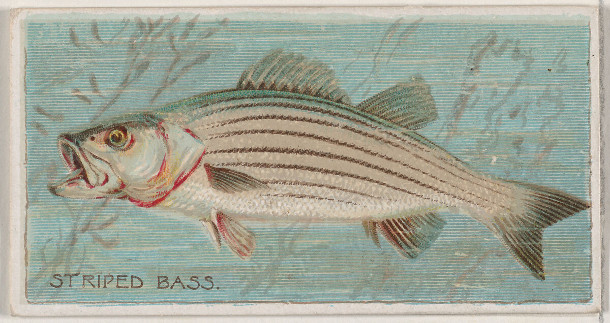
Despite declining populations back in the 1980’s, the Striped Bass is now doing well in part due to the signing of the Atlantic Striped Bass Conservation Act. (Photo: Knapp & Company, The Metropolitan Museum of Art, Public Domain)
CURWOOD: Right where I am along the New England coast, striped bass are back in fairly large numbers. Although the limits are set that you can't get them too small. You can't get them too big. So it makes the sport fishermen throw back almost everything they catch, but when they get to keep one Peter, they taste so good. Well, hey, thanks, Peter. And the next time you chow down on a striped bass at the restaurant at a friend's house, just remember this Atlantic striped bass Conservation Act. Peter Dykstra is a contributor to Living on Earth. And we'll talk to you again real soon.
DYKSTRA: All right, Steve, thanks a lot. Talk to you soon.
CURWOOD: Thanks, Peter. And there's more on these stories on the Living on Earth webpage. That's loe.org.
Related links:
- Learn more about how pumpkins are fighting poverty in the developing world.
- Read a full report explaining the benefits of recycling and reusing construction materials.
- Learn more about the striped bass.
[BIRDNOTE THEME]
BirdNote®: Return of the Extinct Little Blue Macaw

Two blue Spix’s Macaws perch on a tree branch. (Photo: Etna 1984)
DOERING: With a little help, some species can make a miraculous comeback, even from extinction in the wild.
BirdNote’s Lucina Melesio has this story about a recent avian recovery.
BirdNote®
The Return of the Extinct Little Blue Macaw
[Spix's Macaw call]
Even if the name Spix's Macaw doesn’t ring a bell, you might recognize this bird. It’s Blu, from Rio, the animated film!
[Short clip from Rio trailer]
NARRATOR IN TRAILER: He’s about to discover how rare he really is.
VET: Blu is the last male of his kind.
BLU: I have a kind?
Also known as the Little Blue Macaw, they’re medium-sized birds with a gray head, intense blue plumage, and a black and robust beak. But the most characteristic feature of these macaws is their voice: a short and raspy "kraaaa!"
However, by the late 2000s, the bird’s voice… went silent.
[Fade out bird calls abruptly]
They were considered extinct in the wild. Since the 19th century, Spix’s Macaws have been hunted for the pet trade. They lost much of their habitat, the Caatinga, a semi-arid region in northeastern Brazil. To make matters worse, an introduced bee species competed with them for nesting sites.
[Spix macaw habitat soundscape]
A group of Brazilian and German conservationists saved a few individuals. They began a captive breeding program with just seven birds.
But after 20 years of breeding…. Success! Biologists raised the captive population to nearly 200 macaws! They had to be trained to fly, find food, and recognize predators in the wild.
[Spix's Macaw calls]
In 2022, the Spix's Macaw Release Project set free 52 individuals into their ecosystem in Brazil. Their distinctive voice rang out again in the caatinga.
###
Written by Paula Vilella
Senior Producer: John Kessler
Producer: Mark Bramhill
Managing Editor: Jazzi Johnson
Managing Producer: Conor Gearin
Content Director: Jonese Franklin
Bird sounds provided by The Macaulay Library of Natural Sounds at the Cornell Lab of Ornithology, Ithaca, New York. Spix’s Macaw ML57774 recorded by Bret Whitney.
BirdNote’s theme was composed and played by Nancy Rumbel and John Kessler.
© 2023 BirdNote October 2023
Narrator: Lucina Melesio
ID# SPMA-01-2023-10-17 SPMA-01
https://www.birdnote.org/listen/shows/return-extinct-little-blue-macaw
DORING: For pictures, fly on over to the Living on Earth website, loe.org.
Related link:
This story and more on the BirdNote® website
[MUSIC: Instrumental Hotel California]
Just ahead, auto workers and their battle for good paying jobs as the industry electrifies.
Keep listening to Living on Earth.
ANNOUNCER: Support for Living on Earth comes from Friends of Smeagull the Seagull and Smeagull’s Guide to Wildlife. It’s all about the wildlife right next door to you! That’s Smeagull, S - M - E - A - G - U - L - L, SmeagullGuide.org.
[MUSIC: Instrumental Hotel California]
Auto Workers in the EV Fast Lane
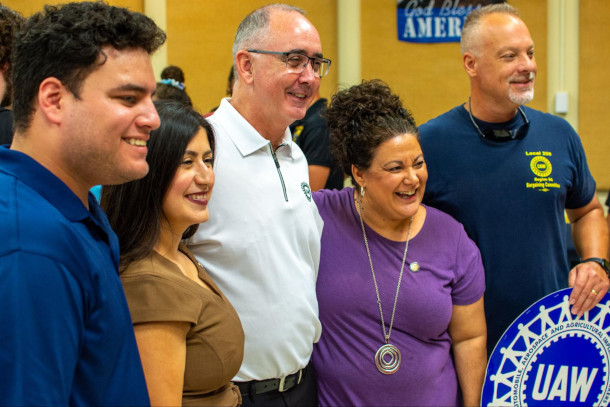
United Auto Workers president Shawn Fein (center) says the shift to EVs should not be a “race to the bottom.” (Photo: Informed Images, Flickr, CC BY-NC 2.0)
CURWOOD: It’s Living on Earth, I’m Steve Curwood.
DOERING: And I’m Jenni Doering.
In mid-September the United Auto Workers began striking for better wages and benefits from auto companies that they say have not given employees their fair share of soaring overall profits. And after a little over a month on the picket lines that saw a visit from President Biden, the union won a major settlement with the Big Three US automakers. That’s General Motors, Ford, and Stellantis, the parent company of Jeep and Chrysler. The settlement of the strike raises questions about what these new contracts mean for the growing electric vehicle industry, its workers, and the public. Joining us from Columbus, Ohio is Dan Gearino, a reporter with our media partner Inside Climate News. Dan, welcome back to Living on Earth!
GEARINO: Good to be here.
DOERING: So what did the UAW get the automakers to agree with?
GEARINO: UAW got some pretty substantial wage and benefit increases. All three of these automakers got pay raises. The GM pay raise is 25% increase in base wages through 2028. If you're a veteran employee, we're talking about hourly pay of more than $40 an hour. Newer employees, we're talking about $30 an hour. So these are just kind of rock solid, middle class wages. They also got some concessions that will enable the union to represent workers at battery plants, either by automatically making some of those employees members of the union or easing the path to union membership at some of the plants.
DOERING: And why were electric vehicles and batteries an important focus of these negotiations?

After a six-week strike, The United Auto Workers labor union gained substantial pay raises and easier paths to unionization for battery plant workers. (Photo: The White House, Wikimedia Commons, Public Domain)
GEARINO: Electric vehicles are the future of this industry. There's a lot of debate about how soon that future is going to be here in terms of when electric vehicles become, you know, even the majority of the vehicles on the road. But just about anyone you talk to, will say there is a point in the future in which we largely transition away from internal combustion engines to electric vehicles. And with that shift, a lot of the jobs in the automotive industry are going to be in battery plants, places where you're manufacturing and assembling the batteries that go in these vehicles. So if you're the Auto Workers Union, you want to be representing those workers. And the way that the industry has kind of developed thus far is that several of the unionized auto manufacturers are building batteries through joint ventures with non union companies. And the UAW really wanted to basically be given a fair shot to try to represent those workers, and that they are getting that in this contract. So what they're hoping to do is by representing workers at some battery plants, the battery plants that are affiliated with these kind of Detroit three automakers, they can then go to other battery plants that maybe aren't affiliated with those and say, hey, look at what we did at this battery plant, maybe in the next state over, look at how much better their job security is, how much better their benefits and wages are. So it can create this positive momentum that can lead to this industry having more union membership, but then also having just higher pay and benefits across the industry.
DOERING: Right, good jobs, instead of having a choice between good versus green jobs.
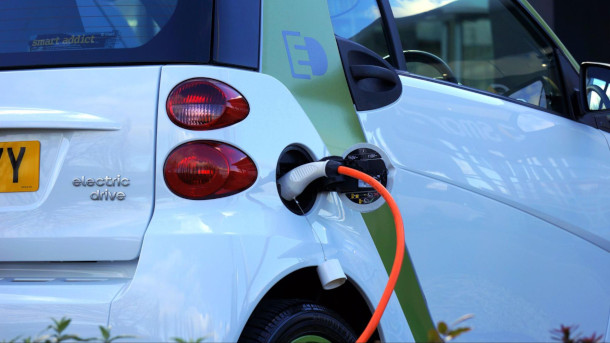
Many jobs in the auto industry will likely become jobs at battery plants. (Photo: Mike Bird, Pexels)
GEARINO: Yes, and that is this major point that the UAW president has been making throughout this strike, that the shift to EVs should not be a race to the bottom in which the new jobs are not as good as the jobs that are going away. And this is a really important issue, just more broadly, in the transition to clean energy. If the jobs that are the backbone of our economy in a lot of communities are going away, and they're being replaced with jobs that are less stable, that don't pay as well, this is bad for local economies, but it's also something that really undercuts the political consensus for the energy transition. It leads to some real resentment.
DOERING: So it seems like the United Auto Workers union has made some positive steps in the short run for the workers they want to represent, namely better wages and easier paths to unionization. But in the long run, what effects might the strike's outcome have on the electric vehicle market?
GEARINO: It's clear that this contract is just step one. And that if there isn't a solid step two, the long term effects here will not be as helpful for these workers and for the industry. So what I mean by that, the UAW wants to use this contract as momentum to be able to organize other automakers, other plants, including automakers and plants that are not affiliated with Ford, General Motors and Stellantis. Now, that's really hard. They've tried that before. They've said they were going to do that before. But if they can do that, that could lead to this increase in wages and benefits across this industry in the United States. But if they can't do that, then what we have is a contract that runs through 2028 in which the costs of labor for those three companies has now gone up. And their competitors are like Tesla, Toyota, Honda, Volkswagen, who have non-union workforces, and lower labor costs. And it creates this competitive disadvantage unless you can find a way to kind of, you know, raise those boats for those other automakers in terms of their pay and benefits.
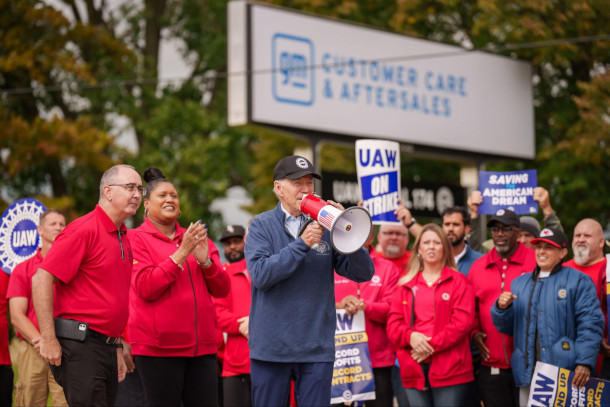
President Biden joined UAW strikers on the picket line in September. (Photo: The White House, Flickr, Public Domain)
DOERING: So looking forward, what actions could the UAW take to try and strike that balance between creating a competitive domestic EV market and still maintaining quality jobs for that market's employees?
GEARINO: So in the bigger picture, what we need to find is some sort of a balance between having kind of a robust economy in which these workers are paid a solid middle class wage and vehicles are affordable, because increasing the labor costs increases the cost of the product. And to say this is a difficult balance to strike is an understatement. So as we look ahead, we need to see what happens at some of those other automakers because these companies are already having trouble with selling vehicles at an affordable price point for most consumers. Cars have gotten super expensive. EVs are expensive. And this is a real issue going forward. So you have a new contract that's going to directly or indirectly increase costs for vehicles from some companies. So it'll be interesting to see what the other companies do in response to this. But yeah, there's this kind of complex set of variables at play here, where you need to be able to sell cars, people need to be able to afford cars, but the people who put the cars together need to be able to make a living wage, and kind of how this shakes out and how good those jobs are, will have a lot to do with how we perceive this transition to clean energy. Is this a good thing? Is this a good thing for my next door neighbor? Is this a good thing for me? And it's tough, these are all incredibly complex and difficult issues.
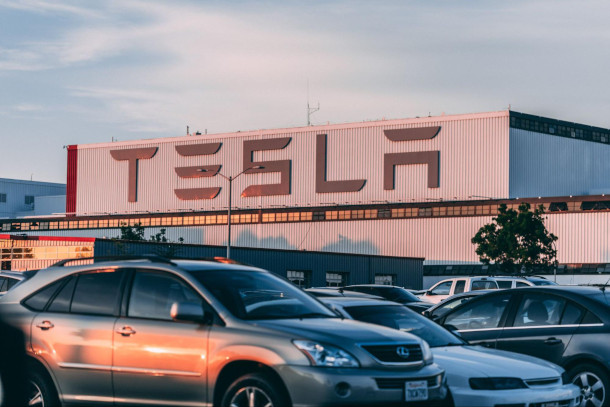
Many auto manufacturers including Tesla, Volkswagen, Honda, and Toyota are not unionized. (Photo: Craig Adderly, Pexels)
DOERING: Dan Gearino covers the clean energy economy with our partner, Inside Climate News. Thank you so much, Dan.
GEARINO: Thank you.
Related links:
- Inside Climate News | “UAW Settles With Big 3 U.S. Automakers, Hoping to Organize EV Battery Plants.”
- The United Auto Workers Website
[MUSIC: I gotta right to sing the blues Tour de force" Played by Louis Armstrong]
Virtual Power Plants
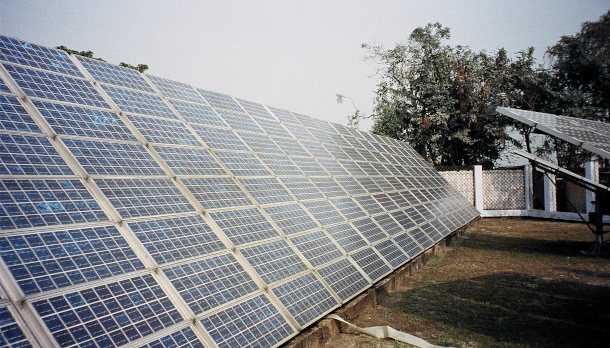
VPPs are networks of small energy-producing and storage devices, such as solar panels and batteries, that are pooled together to serve the electricity grid. (Photo: Hiro Yamagata, Flickr, CC BY-SA 2.0)
CURWOOD: Electric vehicles aren’t just useful for getting you and me from Point A to Point B. With smart policies they could also help decarbonize the grid. That’s because renewables like wind and solar don’t produce electricity around the clock. So there’s often a mismatch between when the power is being generated and when it’s being used. And until it’s needed the big batteries in electric cars and trucks can help store some of that precious power. That’s part of the strategy called “virtual power plants.” A recent report by the consulting firm The Brattle Group estimates that virtual power plants could save utilities and their customers as much as $35 billion over the next decade. Ryan Hledik is a Principal at The Brattle Group and joins us now. Welcome to Living on Earth, Ryan!
HLEDIK: Thanks for having me.
CURWOOD: So what exactly is a virtual power plant? Please explain how they would operate.
HLEDIK: So a virtual power plant is basically a collection of customers, it could be residential households, it could be commercial buildings who have been recruited into a program and are participating in that program and being provided incentives to participate in order to provide some of these services to the grid. It's basically this idea where customers have a lot of flexibility in their demand for electricity. Customers who are buying electric vehicles have the ability to change when they're charging that car to a degree, customers with smart thermostats can manage the thermostat in a way that changes when they're cooling their home. So one example of this could be if you're a customer who had made an investment in a battery at your home, because you wanted to use that battery as a form of backup power during an outage, you could be paid by your local utility or another company to actually allow them to control that battery on a limited number of days per year, limited number of hours per day, to provide services to the grid from the battery. By doing this, the really interesting opportunity that we're seeing here is, first of all, it's a way to directly pay customers to participate in the decarbonisation transition. And then in addition to that, instead of going out and building a gas peaker plant that might only be used 100 hours per year, we're able to tap into an investment that's already been made for other reasons that customers battery, and get more use out of that to provide more of a benefit to the power grid and to society more broadly.
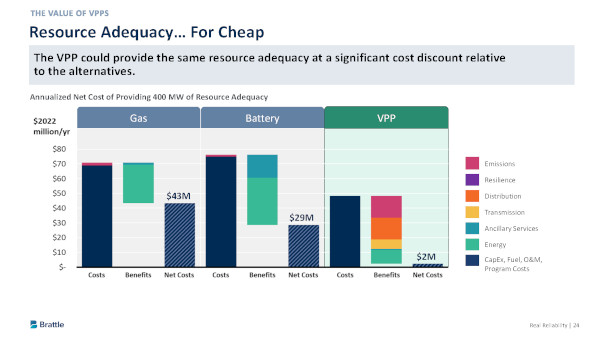
Graph from Brattle Group pointing to costs and savings from virtual power plants. (Photo: Courtesy of The Brattle Group)
CURWOOD: What role do electric cars play in the world of virtual power plants? They have pretty sizable batteries in them.
HLEDIK: Electric cars have sizable batteries, and they're a pretty large discretionary source of flexible electricity demand. So there's a lot of excitement about the potential for electric vehicles to participate in virtual power plant programs, projections that I've seen forecasted that, based on what we're likely to see in terms of electric vehicle adoption, over the course of the next decade, we could have dramatically more energy storage connected to the power grid in the form of electric vehicles and batteries on wheels, then we will see in terms of large utility scale batteries being deployed onto the power grid. So the idea with incorporating electric vehicles into a virtual power plant is that by encouraging customers to shift their charging to those off-peak hours in the middle of the night, when demand is low, or even in the middle of the day, when maybe there's solar power that's being curtailed, because you have more than you need, you can shift the charging load of the EVS into those hours to provide benefits that you otherwise wouldn't have if the customers were to just simply drive home from work and plug their electric vehicle into the wall when they got home.
CURWOOD: But what if somebody wants to get in that car right now and then wants to drive the 200 miles to Aunt Thelmas because she called saying she has an issue?
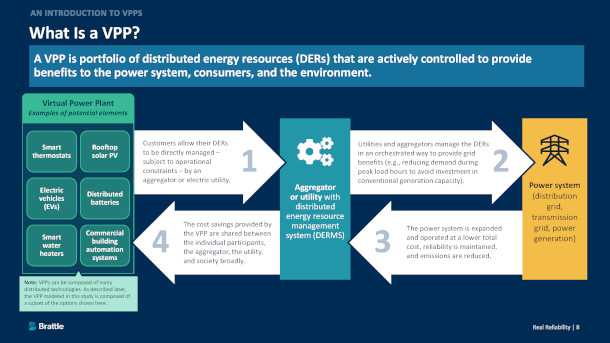
Graph from the Brattle Group explaining the virtual power plants. (Photo: Courtesy of The Brattle Group)
HLEDIK: That's right and one of the important characteristics of virtual power plant programs is they are designed with constraints on how they'll be used to make sure that customer comfort and convenience is maintained. So in the case of an electric vehicle, virtual power plant, you could have a program designed such that customers are always ensured that even if their utility is going to manage how that vehicle is charging overnight, that they will be starting the next day at 6am with a full state of charge in their EV. So those parameters, those rules are built into the program to make sure that they align with customer needs and customer convenience.
CURWOOD: What kind of money could we save in this country if we use virtual power plants rather than trying to just expand the traditional grid infrastructure?
HLEDIK: We looked into the answer to that question in our study and what we found was if we reached a pretty significant but achievable level of virtual power plant deployment by 2030, we could save 15 to $35 billion over the ensuing decade, relative to if we were to make investments and those more conventional gas peakers and utility scale batteries.
CURWOOD: So right now, the burning of fossil fuels in this country is linked to some 300,000 excess deaths a year. What are some of the co-benefits of dealing with the greenhouse gas problem using virtual power plants?
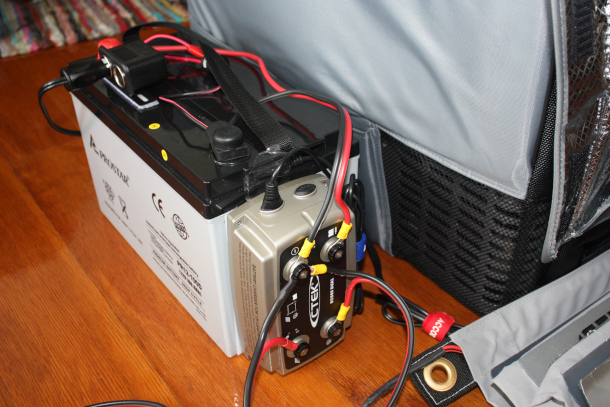
A virtual battery is like a piggy bank that allows you to store the surplus from your solar panels and convert it into a financial discount on your electricity bills. (Photo: Stephan Ridgway, Flickr, CC BY 2.0)
HLEDIK: In our study, we did look at the societal benefits associated with reduced greenhouse gas emissions that would come from the virtual power plant that we modeled. And we estimated that over that same 10 year period, at the level of deployment that I described, there can be an additional $20 billion of benefits associated with improved health and avoiding other detrimental effects that are associated with carbon emissions.
CURWOOD: Let's go back to electric cars for a moment. One of the strange things about electricity is that when you make it, it vanishes unless you figure out some way to store it. But the big old base power plants like nuclear plants, which is I think it's what 20% of the electricity in this country right now or the coal fired power plants, the middle of the night, they're cranking out electricity that's not being used that's just going away, just being wasted. It just disappears, it dissipates unless it's stored somehow. How can the virtual power plant notion take advantage of that? If this could be used to soak up some of that energy that otherwise would go to waste? I mean, charging cars, the middle the night is an obvious one but what are some of the other ways that we could take advantage of that baseload that right now goes to waste?
HLEDIK: It's interesting, and California has, and parts of the Southwest have seen this issue pretty acutely. And those are areas of the US where there's been a lot of solar generation that has been built over the course of the last several years. And so on a mild day, when there's not a lot of demand for electricity in the middle of the day, what we're seeing is there can be times when the sun is shining, when there's a lot of generation, actually, you have baseload generation, and then you have a lot of generation coming from the solar panels that can't be consumed for the reasons that you just described, supply exceeds demand. So providing customers with an incentive to shift their electric vehicle charging load into those hours is one opportunity. But another example would be if customers were to pre cool their homes during that midday period, so that they didn't need to run their air conditioners as much during the evening period. That's one way to shift some of their electricity consumption to the middle of the day. Another option that we've seen, that has been very effective, has been for customers with electric water heaters to use the electric water heater, essentially as a thermal battery, and to use the storage tank of that water heater to heat the water when it makes sense when the sun is shining, when there's more electricity than you need on the system. And then as long as the tank has hot water in it when the customer needs to take their shower, then the customer can take their shower without even noticing any difference in this service that they've received what are called smart water heaters or grid-interactive electric water heaters are a really useful resource for tapping into that type of potential.
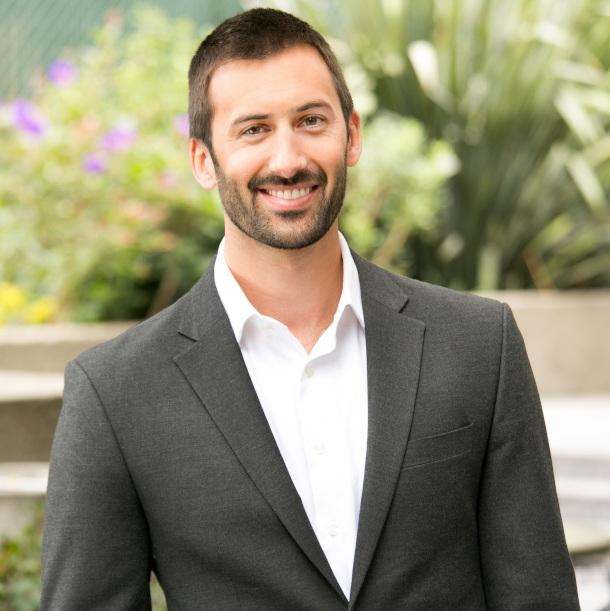
Ryan Hledik is a Principal of the Brattle Group. Mr. Hledik specializes in regulatory and planning matters related to the emergence of distributed energy technologies. (Photo: Courtesy of Ryan Hledik)
CURWOOD: You know, it's interesting, this notion of say pre-cooling a home, it goes against conventional wisdom, people would think well, I don't want to leave the air conditioning on all day when I'm not there. When I come home is when I want to be cool. But virtual power plant thinking inverts that, huh?
HLEDIK: It inverts that and again provides customers with the financial incentive to do something that's good for the power grid and ultimately helps us achieve our decarbonisation goals. One state that you might not immediately think of that has a really interesting program is Vermont and the utility Green Mountain Power in Vermont, where the utility is providing customers with subsidized batteries that the customers get to install in their homes, the customers benefit from having that battery available as a form of backup power. But in return for receiving that heavily discounted battery from the utility, the utility gets to manage that battery during certain days of the year to provide benefits to the power grid. And it's a really interesting kind of win, win situation because the customer gets that resilience benefit, the utility is able to reduce costs on the power grid and keep the power grid reliable. And then on top of that Green Mountain Power is focusing on deploying these batteries in locations of their grid that have lower than average reliability, and where there are customers with lower than average incomes. So it's a great way to provide a lot of benefits in a lot of different ways through a single virtual power plant program.
CURWOOD: All right, well, let's cut to the chase here. This seems like a almost a no brainer idea to move into the area of virtual power plants. What's standing in the way? What are some of the barriers we're seeing when it comes to expanding virtual power plants?
HLEDIK: Well, right now, utilities don't have a strong incentive to adopt virtual power plants. The way utilities make money is by earning a return on capital investment in conventional power grid infrastructure. Poles and wires and power plants. Utilities don't have that same profit opportunity if instead they're using that money to pay customers to reduce their electricity demand. So where I'm hoping we're going to see innovation is around changing the utility regulatory model in a way that provides utilities with an incentive financially to go out and pursue virtual power plants. The other thing that I think is interesting to note here is electrification of transportation and heating is a real opportunity for electric utilities. Not only to be part of the decarbonisation transition and a central player in that, but also it's an opportunity for them to go out and build out power systems and earn a return on those investments to make sure that electrification is happening. And so in that sense, virtual power plants are going to become an enabler for utilities to go out and deploy more capital because it will be part of the agreement with the regulators to do that.
CURWOOD: Ryan Hledik is a Principal at the Brattle Group. Thanks so much for taking the time with us today.
HLEDIK: Thanks for having me on. I really appreciate it.
Related links:
- Learn more about the Brattle Group study on virtual power plants.
- Learn more about Ryan Hledik
[MUSIC: Leo Kottke, “Twilight Time” on Peculiaroso, by Al Nevins/Morty Nevins/Buck Ram, Private Music Records]
CURWOOD: Living on Earth is produced by the World Media Foundation. Our crew includes Naomi Arenberg, Paloma Beltran, Josh Croom, Swayam Gagneja, Mattie Hibbs, Mazzi Ingram, Mark Kausch, Mark Seth Lender, Don Lyman, Sarah Mahaney, Aynsley O’Neill, Sophia Pandelidis, Jake Rego, El Wilson, and Jolanda Omari.
DOERING: Tom Tiger engineered our show. Alison Lirish Dean composed our themes. You can hear us anytime at L-O-E dot org, Apple Podcasts and Google Podcasts, and like us, please, on our Facebook page - Living on Earth. We tweet from @livingonearth. And find us on Instagram at livingonearthradio. And you can write to us at comments at loe dot org. I’m Jenni Doering.
CURWOOD: And I’m Steve Curwood. Thanks for listening!
ANNOUNCER: Funding for Living on Earth comes from you, our listeners, and from the University of Massachusetts, Boston, in association with its School for the Environment, developing the next generation of environmental leaders. And from the Grantham Foundation for the protection of the environment, supporting strategic communications and collaboration in solving the world’s most pressing environmental problems.
ANNOUNCER 2: PRX.
Living on Earth wants to hear from you!
Living on Earth
62 Calef Highway, Suite 212
Lee, NH 03861
Telephone: 617-287-4121
E-mail: comments@loe.org
Newsletter [Click here]
Donate to Living on Earth!
Living on Earth is an independent media program and relies entirely on contributions from listeners and institutions supporting public service. Please donate now to preserve an independent environmental voice.
NewsletterLiving on Earth offers a weekly delivery of the show's rundown to your mailbox. Sign up for our newsletter today!
 Sailors For The Sea: Be the change you want to sea.
Sailors For The Sea: Be the change you want to sea.
 The Grantham Foundation for the Protection of the Environment: Committed to protecting and improving the health of the global environment.
The Grantham Foundation for the Protection of the Environment: Committed to protecting and improving the health of the global environment.
 Contribute to Living on Earth and receive, as our gift to you, an archival print of one of Mark Seth Lender's extraordinary wildlife photographs. Follow the link to see Mark's current collection of photographs.
Contribute to Living on Earth and receive, as our gift to you, an archival print of one of Mark Seth Lender's extraordinary wildlife photographs. Follow the link to see Mark's current collection of photographs.
 Buy a signed copy of Mark Seth Lender's book Smeagull the Seagull & support Living on Earth
Buy a signed copy of Mark Seth Lender's book Smeagull the Seagull & support Living on Earth

